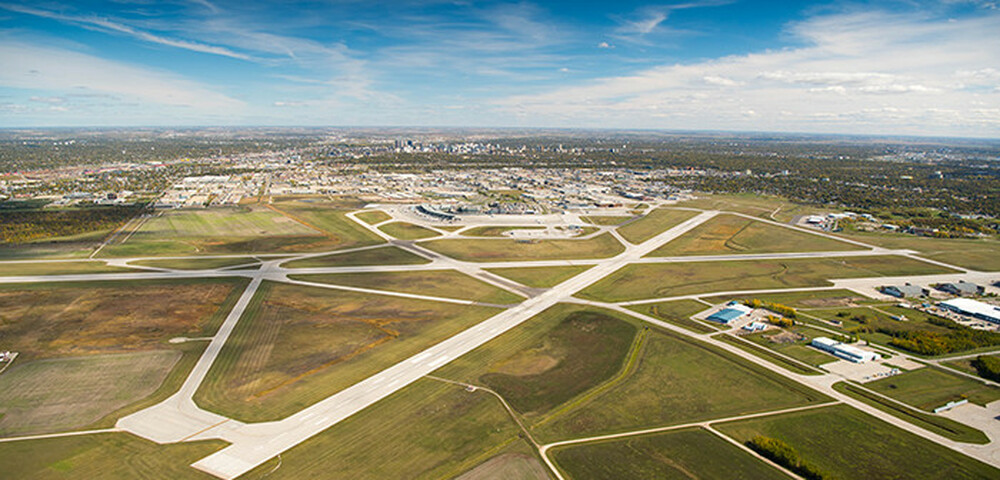Winnipeg Airports Authority has asked the Municipal Board to look into proposed changes to a by-law which protects Winnipeg Richardson International Airport's ability to serve the community around the clock.
Shindico Development and Cadillac Fairview want to amend a longstanding, City of Winnipeg planning framework called the Airport Vicinity Protection Area Secondary Plan so they can develop the area around CF Polo Park into a series of high-rise and low-rise residential buildings. While WAA welcomes the idea of new residential development in St. James, the proposed renderings would risk placing homes in inappropriate locations, potentially under flight paths and without a full understanding of the impacts for the community and the airport. Effective plans level the playing field for all developers by outlining what is possible and what is not, much like the current plans have successfully done to date. Based on the experiences of other cities in Canada and around the world, adding residential development in the flight path leads to increased complaints, community anger, and eventually, restrictions to airport operations, which already generate $4.3 billion in economic impact for Winnipeg and support 18,500 jobs in the community.
The AVPA was created in 1995 as an economic strategy and planning framework for the Province to support Winnipeg in becoming a cargo transportation hub. The plan has long protected the 24-hour operations of the airport and the connectivity of the community by prohibiting residential construction in sensitive areas of the city to limit noise complaints. As a result, Winnipeg has since grown into a thriving cargo hub, as opposed to being a spoke, providing the region with increased access to more communities than a city this size can typically sustain. Noise complaints are currently minimal as this by-law has acted as a proactive defense, shielding the airport from unnecessary friction with community members. Despite aircraft advancements and the use of strategic building materials, noise complaints continue to increase globally in the air transportation sector including in Canada. In Montreal alone, citizens who have moved into new neighbourhoods close to the airport are protesting over the airport's impact on their sleep and quality of life as they advocate to impose a curfew on Montréal-Trudeau International Airport.
A similar situation could occur here if this current spot amendment goes forward. Winnipeg Richardson International Airport, situated in the geographic centre of the continent, is one of the busiest cargo airports in the country. Air cargo plays an integral part in delivering life's essentials for the community, such as most recently moving medical supplies and PPE shipments amid COVID-19 to support the region when it needed it most. Cargo flights are active all night long as industries order equipment and individuals purchase goods from domestic and international markets. The airport also services many early morning passenger charter flights each winter as Manitobans head south on vacations. The airport will not be able to meet growing cargo demands or offer these direct routes if the community is actively objecting to airport operations due to noise pollution.
WAA supports development in our city including new homes in the surrounding St. James area. For 92 years, the airport and neighbourhood have been mutually developing, building each other up and thriving. Now, in the face of a recession, it's extremely important for this pattern to continue. The AVPA should be re-examined based on current best practices and the latest information. WAA has made several attempts to engage the City of Winnipeg in a review, going as far as to secure funding to cover the cost, yet has not been able to obtain a commitment to proceed. To allow for a true review of the issue and the impact it will have on future generations, WAA exercised the option to send the amendment to the Municipal Board ahead of a vote by Winnipeg's city council.
By poking a hole in the AVPA plan, which has created a strong environment for success, it opens the door for other developers to request to do the same. A second request from another developer is already in motion and this amendment is still being considered by Council. How will city council justify saying yes to some and no to others? At what point does a plan with a series of amendments lose its integrity and become just a suggestion? Will suggestions be enough to protect the community's connectivity to markets in the future as well as the operation of the airport and the thousands of families connected to it? This single proposal starts the City down a path that threatens the airport's ability to operate 24/7 and the last thing WAA wants to do is negatively impact its longstanding relationship with the community and impair the wellbeing of local residents in the future.
WAA believes dissecting an existing plan without having a future plan will jeopardize the long-term success of the airport, and ultimately the community it serves. It is intent on taking the necessary steps to give this issue a thorough review and to encourage developing Winnipeg from a strategic framework, rather than on an exception basis.



